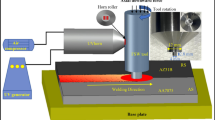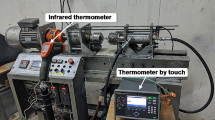Abstract
MIG-brazing is examined as a potential fatigue strength improvement method for welded structures. The fatigue strength of joints produced using MIG-brazing as the primary joining technique and for the improvement of joints welded using traditional welding was studied experimentally. The effect of the improvement for a typical structural steel weld is achieved by a final pass along the weld toe using MIG-brazing. In total, 31 fatigue test results are presented. These include four pilot cases of welded cruciform joints and two main cases of plates with transverse attachments. The results of the fatigue tests were compared to IIW recommendations for as-welded and improved welds. The fatigue strength of MIG-brazed joints was good. For transverse non-load-carrying attachments, an improvement of 70–80 % measured as local nominal stress was gained with respect to IIW recommendations. The fatigue strength of solely MIG-brazed joints and joints improved by MIG-brazing was almost equal. As an alternative joining method, MIG-brazing is used in some industrial applications. This study has given clear indications that this method could also potentially be used as a weld improvement method for new or repaired structures. However, additional research is needed in order to gain more confidence that the degree of improvement can reliably be obtained in production.
Similar content being viewed by others
References
Frings A., Stöckel, S.: Vollmechanisches Metall-Inertgashartlöten von feuerverzinktem Feinblech aus Stahl (Fully mechanised inert-gas metal-arc brazing of hot-dip galvanised thin steel sheet). Schweißen und Schneiden, vol. 32, no. 12, 1986, p. 624–629 (in German).
Haagensen P.J.: Improving the fatigue strength of welded joints. In: Almar-Naess, A. (Ed) Fatigue Handbook. Offshore steel structures, Tapir 1985, p. 259–289.
Kirkhope K.J. et al.: Weld detail fatigue life improvement technologies. Part 1: Review, Marine Structures, vol. 12, no. 6, 1999, p. 447–474.
Haagensen P.J., Maddox S.J.: IIW recommendations on post weld improvement of steel and aluminium structures. IIW document XIII-1815–00, revised 13 June 2002, 42 pages.
Lepistö J.S.: MIG-juotto väsymiskestävyyden parantamismenetelmänä. (MIG-brazing as an improvement method of the fatigue strength). Lappeenranta University of Technology, Department of Mechanical Engineering, Research report 48, Lappeenranta 2004, ISBN 951-764-871-5 (paperback), ISBN 951-764-872-3 (PDF), ISSN 1459–2932, 73 p. (in Finnish).
Hobbacher A.: Recommendations for fatigue design of welded joints and components. IIW document XIII-1965-03 XV-1127–03, update February 2003, Draft for development, 141 pages.
Lihavainen V.M., Partanen T.: Experimental determination of fatigue strength of dynamically loaded welded joints. IIW document XIII-1843-00 / XV-1062–00, 2000, 13 pages.
Author information
Authors and Affiliations
Rights and permissions
About this article
Cite this article
Lepistö, J.S., Marquis, G.B. MIG Brazing as a Means of Fatigue Life Improvement. Weld World 48, 28–40 (2004). https://doi.org/10.1007/BF03263399
Published:
Issue Date:
DOI: https://doi.org/10.1007/BF03263399




